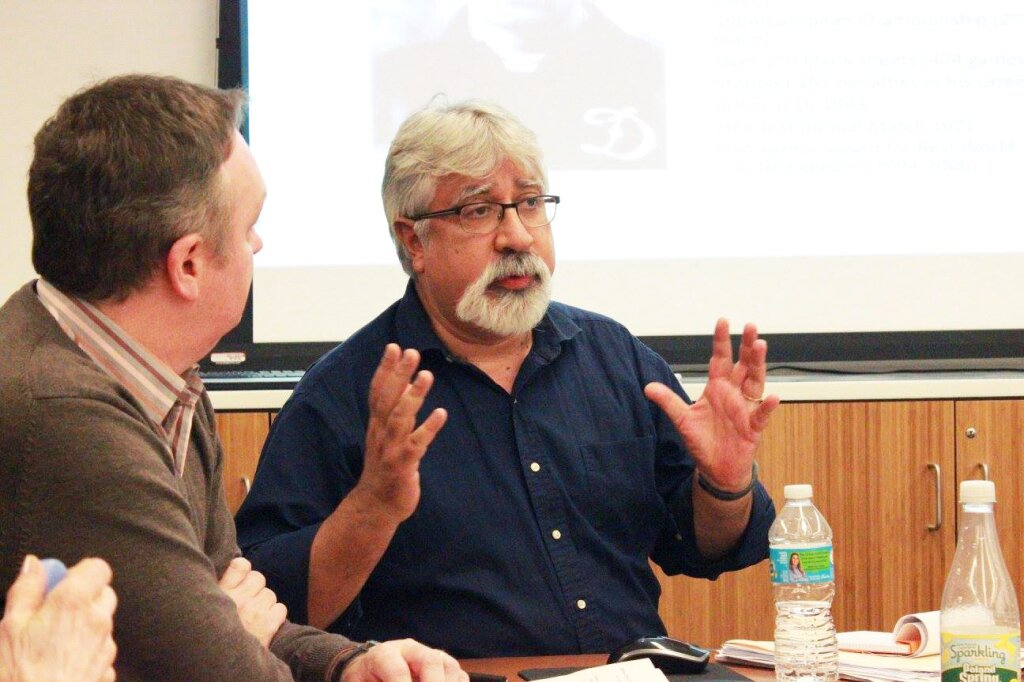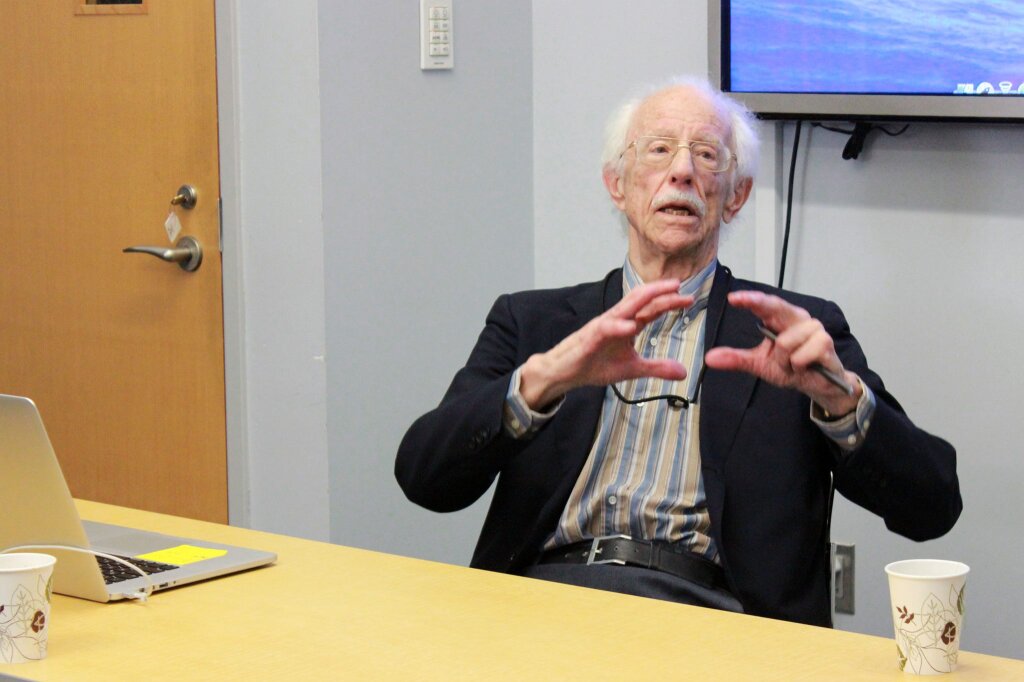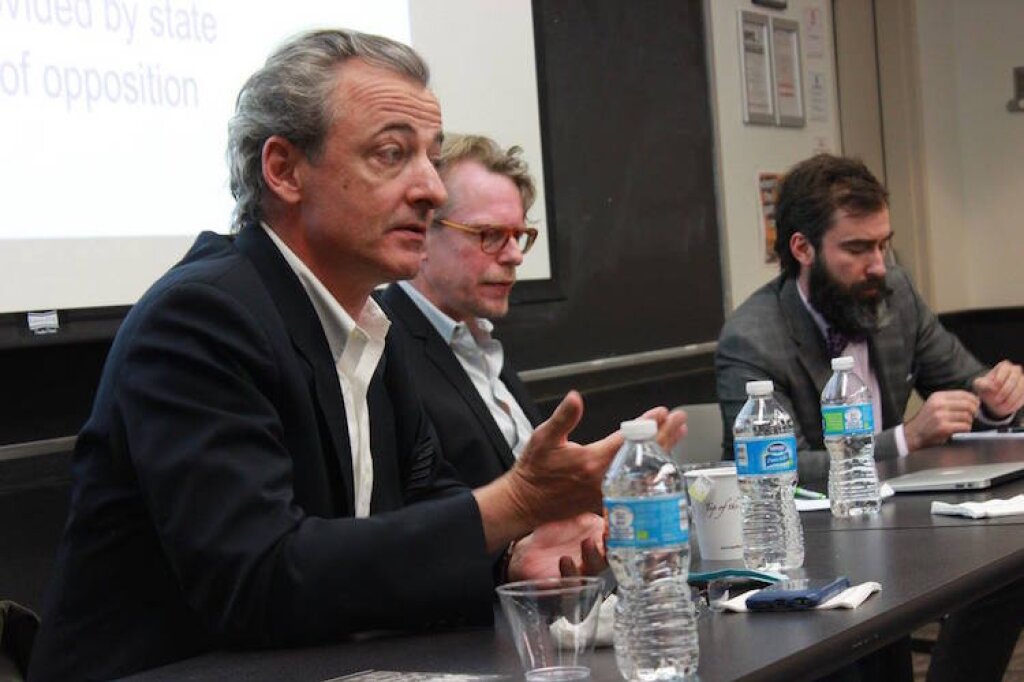On October 24, 2015, the NYU Jordan Center for the Advanced Study of Russia hosted the second part of “The Global History of Sport in the Cold War,” a two-day conference devoted to exploring the role of sport during the Cold War. The event was organized by Professor Robert Edelman from the University of California, San Diego, and Christopher Young from the University of Cambridge. It was supported by the National Endowment for the Humanities, the NYU Department of History, the NYU Center for the United States and the Cold War, the Woodrow Wilson International Center for Scholars, the University of Cambridge, the University of California, San Diego and the NYU SPS Tisch Institute for Sports Management, Media, and Business.
Check out our report from Day 1
Panel 1 | The Post-Colonial
The first panel discussion saw interventions by Rob Ruck (University of Pittsburgh), Brenda Elsey (Hofstra University) and Kate Burlingham (California State University, Fullerton). Martin Klimke (New York University, Abu Dhabi) was called to moderate.
In his presentation, Ruck focused on “Cold War Baseball in the Caribbean.” He stated that baseball evoked a sense of modernity and thus acted as a “rehearsal for democracy” on a symbolic level, but, due to various restrictions, only people belonging to specific races were allowed to play in major leagues in the United States. Cuba, he said, stood in stark contrast and actually embodied the democratic values seemingly inherently part of the game: in the Cuban league, players of all nations and races played with and against each other. He also pointed how baseball became intertwined with the international context in the 1940s, when Mexican Jorge Pasquel started bringing players from the Negro League Baseball to the Mexican League, challenging the hegemony of the Major Baseball League over athletes. Ruck also pointed out that recent changes in the relations between the U.S. and Cuba could bring discussions on baseball to the fore. “Rapprochement is near and that could bring a struggle over who controls baseball over the surface,” he said. Looking at the dynamics in place between leagues and teams in the United States and the Caribbean today, he highlighted how “in the last 25 years, about 100 Cubans have signed contracts with major league teams.”
Elsey gave a different perspective on sport in the Americas with a presentation of her paper, “Cultural Ambassadorship and the Pan-American Games of the 1950s.” She presented the Pan-American Games as an expression of the true belief in making changes through cultural diplomacy. While the games were often presented as the opportunity to showcase the superiority of free market democracy, Elsey noted how other considerations were glossed over, such as the importance of trade. “We can’t pretend that that was not the highest priority,” she said. She also reflected on how the games perpetuated the fantasy of equality among the nations and the role played by women in challenging a system that often condoned their mistreatment during the games.
In the last presentation, Burlingham discussed the findings of her research, summed up in the paper, “Root for the home team? Basketball, International Organizations, and the Nation in Angola.” She prefaced her talk by discussing the challenges presented by any research project focused on Angola, a country both difficult to reach and characterized by a restrictive environment. She then proceeded to narrate the arrival of basketball to the country through YMCA missionaries and how the sport was used by the People's Movement for the Liberation of Angola (MPLA) to gain legitimacy after the end of Portuguese colonialism. In fact, by formally recognizing the MPLA, the International Basketball Federation (FIBA) intervened in the bloody domestic politics of Angola, she said.
During the ensuing discussion, Klimke shared some comments on how assimilation through sport can be a pathway to citizenship and raised questions regarding the anti-colonial edge of baseball, the relationship between the Major League Baseball and the U.S. Department of State and the legacy of transitioning from colonial to post-colonial regimes.
Panel 2 | Making Friends / Enemies
During the second panel, Nicholas Rutter (Fairfield University) and Kevin Witherspoon (Lander University) spoke on their research. Their presentations were followed by remarks from the discussant, Molly Nolan (New York University).
Rutter first discussed his work on Sport at World Youth Festivals (1950-1980), which were first organized in 1947 by the World Federation of Democratic Youth, a left-wing youth group, and the International Union of Students, a nonpartisan organization of university students. His research was summed up in a paper titled “Sport with and against the West:
Athletics at the World Youth Festival, 1947-1989.” Rutter said that the festivals could be seen as an analogy to the Cold War, and more importantly to internationalism, something particularly important since the Soviet Union was unwilling to join many international organizations. Because the World Youth Festival was something that the Soviets could participate in, they “insisted on competition, an Olympic-style event,” Rutter said. This stood in contrast to the position held by Western teams, who claimed to seek only healthy competition when it came to sports. At these festivals, “culture was the main event [...], athletics [came] second,” Rutter said. Despite the many records broken by Soviet athletes and despite a huge press attendance, Rutter said that at the festivals, “there [was] a huge amount of focus on social interactions – between ‘their’ youth and ‘our’ youth – and very little about the sports.” In the Cold War spirit, Western publications generally ignored reporting news about athletics, focusing on the cultural aspects of the festivals or publishing propaganda against attending the World Youth Festivals altogether. Because of this, “the competitive element was gone,” and over time the original Soviet ambition to create a world sporting event declined, Rutter said.
Witherspoon then spoke about his research on black U.S. athletes as diplomats in Africa, as illustrated in the paper “Black American Athletes in Africa: Reflections on the Career of Mal Whitfield.” He focused on the case of track star Mal Whitfield, an Olympic athlete turned international athlete whose tours around the world “helped to promote the U.S. message that the country was promoting all athletes, regardless of race.” “Sports seemed to be moving the US in the right direction,” Witherspoon said. By the 1970s, however, black were no longer willing to improve the U.S. democratic platform, he said. Witherspoon traced through Whitfield’s biography, underscoring his transformation from “good negro to black radical” from the 1950s to the 1960s. After working for many years abroad, Whitfield returned to the United States, expecting “similar progress at home that he had experienced in underdeveloped countries abroad like Laos, where he had witnessed dramatic social progress,” Witherspoon said. Whitfield’s disappointment led him to advocate for a boycott of the 1964 Tokyo Olympics and to become less supportive of U.S. policies. For Witherspoon, Whitfield’s transformation raises questions regarding the efficacy of the State Department’s sports diplomacy program, the role of black elite athletes and their perception of the work that they were doing.
Following the two presentations, Nolan discussed three issues central to Cold War cultural diplomacy—race, youth, and the capaciousness of Cold War competition. She said that she would be interested in hearing more about the reception of these kinds of fronts of cultural diplomacy, the issue of gender, and the role of non-superpowers during the Cold War.
Panel 3 | Constructing Cold War Personalities
In the conclusive panel Jane Brown Grimes (United States Tennis Association), Mauricio Borrero (St. John’s University), Elliot Gorn (Loyola University Chicago), and Annette Timm (University of Calgary) spoke on four different Olympic athletes. Patrick Deer (New York University) served as discussant.
Grimes spoke on Martina Navratilova, the Czech tennis star that defected to the United States in 1975 at age 18. “Eleven years later she returned to her home country as a U.S. citizen and as the number one player in the world,” Grimes said. “Her performance [at the 1986 Federation Cup in Prague] paved the way to the Velvet Revolution.” During Navratilova’s early career, she faced growing restraints and increased surveillance, as socialist authorities worried that she was becoming too “Americanized.” At the Federation Cup, the Czech news was instructed not to film or photograph Navratilova during the game and the umpire was forbidden to use her name, calling her “the woman from the US.” In defiance, the Czech crowd chanted: “Say her name!” Navratilova went on to win the match. “For 11 years, she was a non-person in the country,” Grimes said. “The Czech crowd changed that.”
Borrero spoke about Russian goalkeeper Lev Yashin, the only soccer player spoken about during the entire conference. Borrero’s research centered around Yashin’s ability to become a transnational star, and how studying Yashin’s popularity might influence our current understanding of sport in the Cold War. Borrero said that Yashin served as “a confident alternative to the Western world order,” thanks to his skill, personality and smile. Yashin, who was known to admit his own weaknesses and nerves before a match “helps to humanize Soviet athletes,” who were often criticized for playing soccer too mechanically, Borrero said. Yashin “crosses the border between east and west or east and south in popularity, but also he seems to cross the border between someone who’s safe for the Soviet government to put forward as a personality and someone who’s generally popular with the Soviet public,” he said.
In his discussion of Muhammad Ali, Gorn spoke about the American boxer’s controversial character and more broadly, his inability to escape the logic of the Cold War and racism in the United. “I could argue that Muhammad Ali had nothing to do with the Cold War or I could argue that he single-handedly ended the Cold War,” Gorn said. Active in the civil rights movement and a convert to Islam, Ali “embodied many of the decades’ conflicts,” he added. Gorn quoted Ali saying that he was “the heavyweight champion, but there are some neighborhoods I can’t move into,” reflecting the deep-seated tensions of the era.
Next, Timm discussed Katarina Witt, the East German figure skater – “the most beautiful face of socialism” – and her role as an ambassador of socialism during the Cold War. “We don’t really understand Katarina Witt’s story if we believe that capitalism wins because sex sells,” Timm began. Witt “helpfully counteracted the dour image of female Eastern European athletes [...] serving her nation as an advertisement for freedom in the GDR,” she said. For example, Timm quoted Witt saying that “her parents could not have afforded to put her through a figure skating program if she lived in capitalist country.” Over time, Witt became an international diplomat and a Sports and Goodwill ambassador to UNICEF. Her spread in Playboy in 1998 demonstrated how the GDR used sexual freedom as a weapon – Witt’s image was both one of Western sexuality and of real living socialism. A true ambassador of socialism, Witt’s demise was concurrent with the fall of communism. “Ostalgie is what killed her,” Timm said.
After the presentations, Deer remarked that the four papers “enabled us to think about different kinds of logics that were at work during the Cold War” and the “transgressive power of writing and thinking about sport [… that] allows us to cut across and draw together different spheres.” Deer mentioned that sport is an incitement to discourse, and asked the presenters to think about how best to capture the narrative of each of their athletes’ stories.
Additional reporting by Ilaria Parogni



